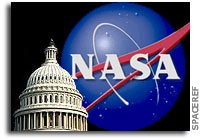Letter from IFPTE to Senators Mikulski and Shelby Regarding NASA’s Proposed FY 2011 Budget

April 22, 2010
The Honorable Barbara Mikulski
Chair, Commerce, Justice, Science Appropriations
144 Dirksen Office Building,
Washington, DC 20510
The Honorable Richard Shelby
Ranking Member, Commerce, Justice, Science Appropriations
123 Hart Office Building,
Washington, DC 20510
Dear Senators Mikulski and Shelby:
The International Federation of Professional and Technical Engineers, NASA’s largest federal employee union, strongly supports President Obama’s proposed fiscal year 2011 (FY11) budget for the National Aeronautics and Space Administration (NASA).
First and foremost, in a time of severe fiscal pressure, President Obama has shown his confidence in NASA by proposing that NASA receive $19 billion in FY11, a $275.7 million dollar increase in its top line over the enacted FY10 level.
Second, in support of NASA Earth and Space Science, President Obama is proposing an augmentation of $512.3 million for NASA’s Science mission, which will accelerate the development of decadal survey missions and increase the support for NASA and academic scientists and their students across the country.
Third, in support of NASA Space Technology and Aeronautics, President Obama is proposing to invest $1.15 billion to renew NASA’s scientific and technological research, which will restore core capabilities at the Research and Technology (R&T) Field Centers so badly neglected over the last 6 years.
Fourth, as part of his unwavering commitment to Human Space Flight, President Obama is proposing to increase NASA’s Space Exploration budget by $483.6 million.
Fifth, because President Obama understands the problem of workforce disruption during any programmatic transition, he has proactively proposed specific, aggressive steps to protect NASA’s core capabilities at its Field Centers. In particular, to put America on a sustainable course for Human Exploration beyond Low-Earth Orbit (LEO), the President is proposing to invest $559 million to accelerate the development of a new Heavy-Lift vehicle and to support critical research on in-space propulsion, which will nurture core capabilities at Marshall Space Flight Center and Glenn Research Center. These FY11 research and analysis efforts should mature as soon as possible into a NASA-led vehicle-development program to support extended-duration Human Exploration beyond LEO. Furthermore, judicious allocation of Constellation transition funds should be used to augment the Heavy-Lift effort by fully leveraging the Ares I workforce and capabilities. In addition, the President is also proposing to invest $429 million to develop a 21st century launch complex that will revitalize and extend the Kennedy Space Center’s Human and Robotic Space Flight capabilities.
IFPTE believes that the revitalization of NASA’s R&T missions is absolutely critical to the Agency’s success and to America’s vital national interests. In that vein, we ask that you pay particular attention to how these funds are allocated so that they provide maximum benefit to the Agency and the taxpayer. In particular, we ask that you work with the Administration to segregate all R&T funds from the operational and vehicle-development programs. To that end, control of all space-related research activities and funds (i.e., Fundamental Space Biology, Human Research [Space Life Sciences], Microgravity Physical Sciences, Space Technology Research and Development, along with a significant portion of the ISS utilization augmentation) should transferred to the Chief Scientist and Chief Technologist, who can isolate and protect these relatively small yet critical long-lead strategic efforts from the short-term tactical needs of those Centers and Programs dealing with large and immediate operational and development demands.
In the President’s speech at the Kennedy Space Center last week, he announced his intention to maintain the Orion program, modified to provide an additional emergency escape vehicle for the International Space Station. Given that this decision reverses the initial proposal to cancel Orion altogether and will leverage Commercial launch capabilities sooner, this new proposal should be funded from the Constellation transition and Commercial Space funding lines (and potentially from the Flagship project of the Technology Demonstration program). To preserve the fundamental logic and vision of the President’s plan, the descoped Orion project should not be allocated more than $500 million from the President’s existing funding lines in FY11, consistent with the narrow scope outlined in the President’s speech. If Congress wishes to broaden the scope beyond the proposed ISS escape-pod role, IFPTE asks that they also provide the significant plus-up to NASA’s top line needed to properly fund such a major effort.
The greatest strength of the President’s budget is that it is honest and forward-looking; in February, President Obama asked NASA to deliver $19 billion worth of work for $19 billion in funding and invested the necessary attention back into long-term R&T so that America can someday lead a crewed mission into deep space. To those in Congress who argue passionately and cogently that NASA should do more and move faster, we say “show me the money”. IFPTE would support an increase in NASA’s workload as long as it is linked to an appropriate increase in funding. Never again should NASA be asked to deliver $22 billion worth of work for $19 billion in funds as this is a formula for failure.
The last two Presidents have promised Mars as a Human Exploration destination, yet we are as far away from that today as we were when President Bush announced his Vision for Space Exploration. Why? Because near-term responsibilities and corporate interests have dominated decision making with critical long-term R&T postponed again and again. To those who argue passionately and cogently for a crewed mission to Mars, we say “show me the technology”. For NASA to send humans to Mars (or an asteroid) and back, safely and cost-effectively, it first needs to make major breakthroughs in both spaceflight and human-support technologies. This will require long-lead research into in-space propulsion, power generation and storage, closed-loop life support, material science, space life science and human factors, automation, thermal protection, cryogenics, and other areas. One thing is sure; if we don’t start, Mars will remain 20 years away forever.
Sincerely,
Lee Stone
President
NASA Council of IFPTE Locals








